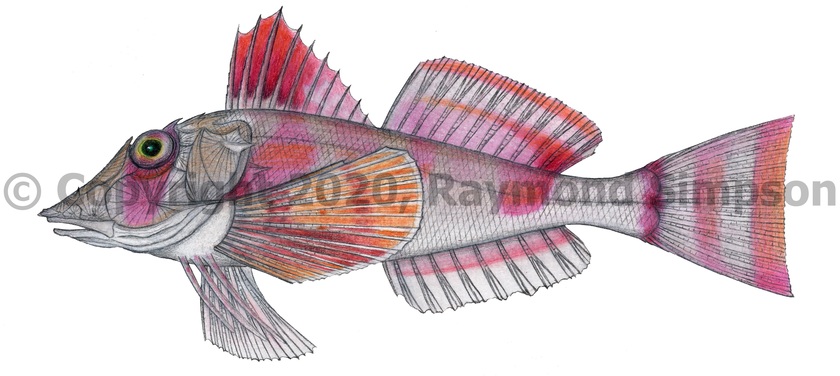
Common Name
Red Searobin
Year Described
Ginsburg, 1950
Identification
Dorsal Fin: X, 11-12
Anal Fin: 10
Pectoral Fin: 13-14
Body relatively stout but elongate and slightly compressed . Head is large, bony, and heavily sculptured with pronounced ridges and spines. Head relatively deep. Duck-billed snout is long. Mouth is subterminal and large in size, containing bands of villiform teeth on the jaws, vomer, and palatines. Jaw reaches under anterior orbit. No spines at nostrils. Preopercle and opercle usually bear strong spines. Preopercular spine reaches edge of opercle. Large, fan-like pectoral fins with strongly branched rays, with the lower three rays free, thickened, and separate from the fin membrane. Pectoral fin viewed from above squared off anteriorly and posteriorly, with a straight to slightly concave outer margin. Pectorals when folded reach anterior third of anal fin base. Two dorsal fins: one spiny and one soft rays. Anal fin opposite soft dorsal fin. Caudal fin is truncate. Pelvic fin underneath pectoral fin on belly. Body covered in small ctenoid scales with the exception of the naked ventral surface. Chest and throat naked. Nape scaled. Opercular membrane above spine partially scaled. Lateral line is continuous.
Color
Body and head gray with brown or reddish mottling, spots and blotches. Blotches enlarge to form irregular bars, especially under the dorsal fins. Spiny dorsal largely reddish with or without obvious spot between spines 4-5. Soft dorsal fin pale pale with a reddish margin and thin white edge. Pectoral fin dark red with a dominant whitish center band running from the middle of the rear margin to the tip of the fin. There are a few other thinner whitish bands on the posterior 2/3 of the fin. The anterior third of fin plain reddish with white rays. Anal fin pale reddish with a white margin. Pelvic fin cream to reddish. Caudal fin cream with three distinct reddish or orange-red bands.
Size
Maximum size to 38cm SL.
Habitat
Soft bottoms from 15-200m (usually shallower)
Range
Southern Brazil to northern Argentina.
References
Carvalho-Filho, A. 2023. Fishes of the Brazilian coast. Literare Books International, São Paulo: 1-424.
Other Notes
Known only from the southwestern Atlantic but closest to Prionotus beanii in coloration and shape but has a much larger mouth.